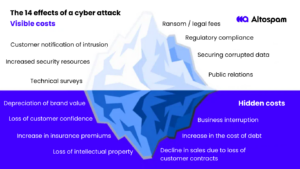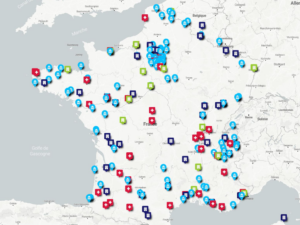Test Altospam’s solutions!
Thousands of companies, CTOs, CIOs, CISOs and IT managers already trust us to protect their e-mail against phishing, spear phishing, ransomware, …

For companies, a cyber attack encompasses any permanent threat to a system. Cyberattacks can originate from internal users, most often victims of phishing attacks, or from hackers external to the organization who manage to exploit vulnerabilities detected online. The major problem with cyber attacks, whatever the size of the company, is their invisible cost.
What many companies fail to foresee is the millions of euros that evaporate as a result of these attacks. As well as being financially devastated and losing sensitive data, they jeopardize the trust of their customers. No company is immune to these threats.
Hackers are creating increasingly sophisticated tactics to deceive their victims. The most common e-mail threats are as follows:
In France, the average cost is 59,000 euros for 385,000 cyberattacks detected by consulting firm Asterès. This figure does not include companies with fewer than 10 employees. This represents an average of 2 attacks per organization. SMEs (fewer than 250 employees) are the most frequently affected, with 330,000 successful cyberattacks. By comparison, ETIs (between 250 and 5,000 employees) and large corporations suffered just 17,000 successful attacks. The remainder targeted public organizations.
The loss of revenue does not only concern sales, but also insurance costs, monitoring costs, notification costs, loss of stock market value, legal costs, ransoms…
A cyber-attack can damage a company’s employees and teams. It can have a significant impact on their state of mind and quality of life at work. It triggers feelings of powerlessness, vulnerability and betrayal… At this stage, the impact is aimed directly at human mental health, causing anxiety and stress on a daily basis, especially for IT managers and directors. The most effective approach to countering a cyber attack is to contact a cybersecurity expert.
The impact of a cyber attack on a company is not only financial, but can also affect: the company’s reputation, its productivity, its activities, the legal and regulatory consequences for the company, its customers…
The consequences of a cyber attack are reflected over several years in the form of hidden costs. Many of these are less easily measurable: damage to corporate image, business interruption, loss of confidential information…

This iceberg is a perfect illustration of what we call hidden costs. On the one hand, above the surface: the best-known costs. On the other, below the surface: the invisible costs. That’s why it’s always better to prevent an attack than to have to recover from it completely.
A number of cyberattacks have left their mark, with successful attacks targeting major domains. These include an attack on TV5 Monde (2015), an attack on the French Ministry of Foreign Affairs (2019), an attack on EDF (2021) and many more…

To protect your company against cyber attacks, it’s essential to implement advanced security solutions. In fact, e-mail filtering and threat detection solutions are needed to secure your business e-mail systems against phishing attacks, malware and other threats.
In conclusion, companies are exposed to the risk of increasingly sophisticated cyber-attacks. The consequences are disastrous, hence the need to strengthen their online security. This includes a combination of phishing awareness and advanced technologies like Altospam’s Mailsafe (anti-phishing, anti-spear phishing, anti-malware and anti-ransomware). Against this backdrop, Altospam, with over 20 years’ expertise in e-mail security, offers sovereign, effective solutions with a false positive rate of just 0.01%. These solutions help companies guard against online threats, protecting their reputation and their finances. Cybersecurity is not just an expense, but an essential investment in a company’s future.
Test Altospam’s solutions!
Thousands of companies, CTOs, CIOs, CISOs and IT managers already trust us to protect their e-mail against phishing, spear phishing, ransomware, …